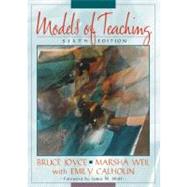
| Foreword | xvii | ||||
|
|||||
| PART I FRAME OF REFERENCE We have used the knowledge base about teaching to identify and create models of teaching and learning that increase student capability. As authors, we succeed by helping our readers inquire more powerfully into our common knowledge base, into their own learning, and into the learning of their students. | 1 | (28) | |||
|
3 | (10) | |||
|
13 | (16) | |||
| PART II THE SOCIAL FAMILY OF MODELS We study the social models first because developing the community of learners is critical to all teaching. We find that the social models are designed to achieve serious academic objectives, including the study of social values, public policy, and resolving conflict, for which the social models are eminently suited. | 29 | (94) | |||
|
31 | (26) | |||
|
57 | (20) | |||
|
77 | (20) | |||
|
97 | (12) | |||
|
109 | (14) | |||
| PART III THE INFORMATION-PROCESSING FAMILY OF MODELS | 123 | (160) | |||
|
127 | (16) | |||
|
143 | (18) | |||
|
161 | (30) | |||
|
191 | (24) | |||
|
215 | (32) | |||
|
247 | (14) | |||
|
261 | (14) | |||
|
275 | (8) | |||
| PART IV THE PERSONAL FAMILY OF MODELS The learners do the learning. How we generate the kind of self-directed independence that enables students to take charge of their development has been the subject of important lines of inquiry for centuries. We visit two models that have emerged in their contemporary form from the search for ways of developing self-understanding and self-esteem. | 283 | (34) | |||
|
285 | (16) | |||
|
301 | (12) | |||
|
313 | (4) | |||
| PART V THE BEHAVIORAL SYSTEMS FAMILY OF MODELS All the creators of models of teaching are optimists, but none more so than the behavioral systems designers. They see us as a collection of learned behaviors that can always be enhanced. Whatever behaviors we have learned that do not work well, such as phobias, we can unlearn; we can then substitute productive patterns for those behaviors. | 317 | (46) | |||
|
323 | (14) | |||
|
337 | (10) | |||
|
347 | (12) | |||
|
359 | (4) | |||
| PART VI SYNTHESIZING AND APPLYING MODELS OF TEACHING We create multimodel curricula and schools and study how they can create equity and bring high states of growth to all learners. | 363 | (80) | |||
|
365 | (20) | |||
|
385 | (12) | |||
|
397 | (14) | |||
|
411 | (6) | |||
|
417 | (16) | |||
|
433 | (10) | |||
| Afterword | 443 | (2) | |||
|
|||||
| APPENDIX PEER COACHING GUIDES These guides are designed to facilitate planning for practice with nine of the most commonly used models of teaching and to provide formats for observing demonstration and peer practice. | 445 | (2) | |||
| Advance Organizer | 447 | (4) | |||
| Cooperative Learning Organization | 451 | (4) | |||
| Jurisprudential Model | 455 | (6) | |||
| Synectics | 461 | (5) | |||
| Concept Attainment | 466 | (6) | |||
| Inquiry Training | 472 | (4) | |||
| Assists to Memory | 476 | (5) | |||
| Role Playing | 481 | (4) | |||
| Inductive Thinking | 485 | (6) | |||
| References | 491 | (38) | |||
| Index | 529 |
The New copy of this book will include any supplemental materials advertised. Please check the title of the book to determine if it should include any access cards, study guides, lab manuals, CDs, etc.
The Used, Rental and eBook copies of this book are not guaranteed to include any supplemental materials. Typically, only the book itself is included. This is true even if the title states it includes any access cards, study guides, lab manuals, CDs, etc.